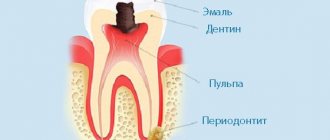Toothache has its own properties and characteristics. Based on how exactly the tooth hurts, the dentist can make a diagnosis and carry out treatment. For example, acute sudden pain radiating to the jaw or temple most often indicates inflammation of the nerve of the tooth - pulpitis. Aching periodic pains that subside on their own indicate a chronic process, possibly periodontitis, etc.
Tooth sensitivity when pressed can be caused by several diseases.
— 15% on the first visit
Main reasons
Pain is a kind of “alarm” from the body, drawing attention to malfunctions in its functioning. The oral cavity is no exception: if a seemingly healthy tooth hurts when pressed, this indicates that something has happened to it. As a rule, the reason is damage to the crown, root, gums, or the presence of an inflammatory process. But provoking factors can be very diverse: injuries, infections, insufficient hygiene and even medical errors. Let's look at each case in more detail.
What diseases can this be a symptom of?
When teeth lose the support that supports them, through progressive and irreversible destruction of the surrounding alveolar bone, mobility and subsequent fall occur. In adults, periodontitis is the leading cause of tooth loss. The disease usually begins with redness and bleeding of the gums (spontaneous or when brushing your teeth). Molar tooth pain is also possible.
Periodontal disease is caused by bacteria that attack and infect the gums, causing inflammation. This infection causes wear and resorption of the bone that contains the roots of the teeth. And this is also the main cause of loose teeth in adults, as the root loses its anchor and causes tooth loss if not treated on time.
Among the causes of this disease is poor oral hygiene. You need to brush your teeth after every meal and use dental floss. Genetics is also one of the reasons, so you need to be extra careful, if a family member has lost teeth due to this reason, it is better to exercise caution.
The tooth hurts when you press on it: after depulpation (nerve removal)
The pulp is nerve fibers and vessels that provide sensitivity and nutrition to the tooth. After their removal, the tooth is considered dead, and it may seem that this is the solution to any problem, because a dead tooth is unlikely to hurt. This is wrong. A pulpless tooth can be disturbing for several reasons:
- if the dentist, while cleaning the canals, punctured the root;
- when the thin end of the endoscopic instrument breaks off and remains inside the canal;
- in case the dental canals have not been completely cleaned and an infection remains in them.
In the first two cases, the pain is quite sharp: the pulpless tooth hurts not only when pressed, but even when touched lightly. If the dentist cleans the canals poorly, pain appears after some time. In any case, a tooth without a nerve that causes discomfort is a reason for a repeat visit to the dental office.
Periodontitis
Sometimes painful sensations occur in a tooth from which the nerve has already been removed. When pressed, the tooth hurts and aches. Many patients are perplexed as to how a fully treated organ can produce such symptoms. However, treatment is not always of high quality. The following mistakes may be made during canal filling:
- perforation of root canal tissues with an endodontic tip;
- incomplete cleansing of nerve tissue from the canal;
- poor quality disinfection of treated canals;
- insufficient tightness of canal sealing;
- the use of cheap fillings that can dry out over time.
All of the above reasons lead to various complications in the dental cavity. Of course, this does not happen immediately after treatment: it may take a month, and sometimes several years. However, such therapy will sooner or later make itself felt. The causing tooth will begin to ache at night, and then will react with pain to any pressure. The essence of periodontitis is the penetration of infection into the tissues of the dentoligamentous apparatus. Through the tip of the root canal, pathogenic bacteria enter the periodontium. There they slowly spread, forming cysts and granulomas of various types. Treating this type of inflammation is quite difficult and takes a long time, and a large percentage of such diseases require removal of the neglected organ.
When the first symptoms of periodontitis appear, dentists recommend following the following tips:
- If a tooth hurts when biting, it is strictly forbidden to apply heat to the sore spot;
- take one or two tablets of painkillers such as paracetamol, tempalgin, analgin;
- brush your teeth, removing food debris from the carious cavity of the affected tooth;
- rinse your mouth several times a day with a solution of potassium permanganate, soda or furatsilin;
- Do not take anti-inflammatory drugs or antibiotics without a doctor’s prescription.
In order to prevent unpleasant consequences for the health of the body, treatment of periodontitis should not be postponed and hope that the disease will disappear over time. A timely visit to the dentist will preserve not only the health of the tooth, but also the entire body, since periodontitis contributes to the emergence and spread of harmful substances. Of course, toxins will negatively affect the functioning of internal organs and a person’s well-being.
The LeaderStom network of clinics specializes in dental therapy, orthodontics and prosthetics. Our specialists try to cure even the most advanced cases of chronic pulpitis and periodontitis with maximum preservation of natural dental tissues. Treatment tactics depend on the degree of neglect. In the initial stages, the disease can be eliminated by refilling the canals. By eliminating the source of infection, dentists achieve stable remission of the tooth and restoration of periodontal tissue. If the inflammation process has covered a large area of tissue, and a purulent process has already formed near the apex of the root, then in this case either surgical intervention or removal of the diseased tooth is possible.
Tooth hurts when pressed after filling
Slight pain after the doctor has given a filling to the patient is normal: during the sanitization of cavities affected by caries, the tissues receive microtrauma. The condition is easily treated with analgesics and goes away on its own in 2-3 days. But if a filled tooth hurts when pressed hard enough, then the problem is one of five reasons:
- high filling - the occlusion is disrupted, the tooth experiences excessive pressure and becomes painful;
- the dental pulp was burned when the filling was treated with a photopolymer lamp;
- a gap has appeared between the filling and the enamel, into which bacteria and food particles have entered, causing inflammation;
- the cavities affected by caries were not drilled out thoroughly enough, and it reappeared;
- I developed an allergy to the filling.
If the tooth under the filling hurts when pressed, this means that you need to make an appointment with the doctor again and have it filled again.
Can a dead tooth hurt?
Before answering this question, let’s find out what the concept of “dead tooth” means? This is the common name for a tooth in which, for medical reasons, the pulp has been removed - loose fibrous tissue penetrated by nerve endings, blood and lymphatic vessels. We are talking about depulpation (removal of the pulp) in case of inflammation for various reasons: due to advanced caries, fistulas, cysts, etc.
Calling a pulpless tooth “dead” is not entirely correct. It is indeed separated from the circulatory system and the nervous system, but is still a component of the dentofacial apparatus, where each element affects the condition of the others.
Pain in a tooth with a removed nerve most often means that other parts of the system are involved in the pathological process, “transmitting” unpleasant sensations to the tissues associated with this tooth. Thus, a false impression is created that the pulpless tooth hurts.
The treated tooth hurts when pressed after canal filling
Working with roots requires precision and accuracy from the doctor. If he incorrectly assessed the depth of the canals, then the following complications cannot be excluded:
- a tooth without a nerve hurts when pressed if the filling material extends beyond the apex of the root, gets into the gum and puts pressure on it;
- when the channels, on the contrary, are not completely filled, inflammation may begin in the voids over time. If a lot of time has passed after visiting the doctor, and the tooth aches and hurts, then the problem is the unsatisfactory filling of the canals.
Treatment of a dead tooth in dentistry
The treatment method for pain in a tooth with a removed nerve depends on the reasons that caused this condition. The dentist will conduct an examination and, if necessary, prescribe an x-ray examination.
- If the cause is unsatisfactory treatment, the filling material is removed, preparation is carried out again, and the canals are inspected with medications placed in them. Then, when the condition returns to normal, the tooth is refilled.
- If the roots are curved, it may be necessary to remove the part that prevents the canals from being cleaned and sealed.
- The cyst or granuloma must be surgically removed along with the pathologically changed tissues around it.
- If there is inflammation of the gums, complex treatment is prescribed. This includes professional teeth cleaning with stone removal, placing medications in periodontal pockets, and taking systemic medications.
- If indicated, physiotherapy procedures are prescribed that have a therapeutic effect on hard tissues.
Remember: by delaying a visit to the dentist, hoping that the pain will go away on its own, you increase the likelihood of serious complications, the treatment of which will be lengthy and possibly expensive.
The tooth under the crown hurts when pressed
Crowns and bridges can also cause many unpleasant moments for their owner. Normally, you may feel discomfort under the crown for several days after installation, but as you adapt, the pain gradually goes away. If a month later the tooth still aches a lot and hurts when pressed, and also if the pain under the crown appears suddenly, this is a reason to consult a doctor.
There are four main reasons:
- the crown became loose, food particles and plaque accumulated under it, and inflammation began;
- the crown is cracked or split;
- the tooth is poorly ground under the crown;
- The shape of the crown is chosen incorrectly; it puts pressure on neighboring teeth or gums.
Pulpitis
Inflammation of the neurovascular bundle of the tooth is one of the most common diagnoses with which patients come to the dentist. Most often, pulpitis occurs due to untreated caries, which destroys the hard tissues of the tooth and reaches its core. As already mentioned, pulpal pain when pressed is very sharp, they are characterized as a “lumbago”. Nerve endings give the most severe symptoms, so it is very difficult to tolerate this phenomenon. You should not rely only on painkillers. It is better to consult a dentist to get timely help for your tooth.
A healthy tooth hurts when pressed
What should you do if, when pressed, a tooth that has not been sanitized, depulped, drilled or loaded with a crown hurts? Yes, this happens too. Here are a few reasons why a seemingly healthy tooth can be painful.
- Periodontitis. This is an inflammatory disease of the tissues around the teeth. When pressed, both the gums and the tooth hurt at the same time. If no action is taken, progressive periodontitis will lead to a reduction in the volume of the gums and even bone, and then the tooth will become loose and may fall out.
- Excessive enamel sensitivity. It is provoked by chemical teeth whitening, after which even a tooth with a nerve can ache when biting or drinking cold and hot drinks. Teeth with filled canals do not have this problem. You can make your enamel less sensitive at home by using remineralizing gels and toothpastes.
- Removal of a tooth. After surgery, the adjacent healthy tooth may hurt. This is due to damage to soft tissues and does not require any additional therapy other than that prescribed by the doctor.
The second group includes:
Incorrectly processed filling
Almost always, modern treatment at the dentist is carried out under local anesthesia (pain relief). In this state, not only do you not feel pain, but your other sensations may also be dulled. And when the doctor “grinds” an already placed filling to the teeth from the opposite jaw, he may, based on your dull sensations, do this not in full. The filling will come into contact with the teeth of the opposite jaw prematurely, which may cause pain.
Pain after root canal filling
Perhaps this is the only reason, most often not a sign of any big troubles. After endodontic treatment (“nerve removal”), possible pain when biting on a tooth is considered normal for 1.5-2 weeks. This happens due to dense obturation (filling) of the root canal system, the presence of microtrauma in the area of the root apex, etc.
The reasons I described above are the main ones, and there are a large number of less common diseases and situations in the oral cavity that can lead to pain when putting pressure on the tooth. In any case, when this symptom appears, the first thing to do is contact your dentist, and if a telephone consultation is not enough, then make an appointment.
What should you do if your tooth hurts when you press it?
Pain almost always accompanies the rehabilitation period after dental surgery. If the patient follows the doctor’s recommendations, the discomfort disappears on its own after 2-4 days, however, in some cases, pain can signal complications. The patient should return for a follow-up appointment if:
- immediately after the anesthesia wears off, severe and sharp pain appears;
- More than a week has passed after treatment, but the toothache does not go away;
- The rehabilitation period went well, but after 1-3 months pain appeared again.
The most important thing is not to endure, but to figure out where the pain comes from.
How to relieve pain at home
With moderate syndrome, you can cope with pain using traditional recipes.
- Rinsing with a soda-salt solution will help alleviate the condition; decoctions of medicinal plants: oak root, sage, chamomile, calendula.
- A paste of garlic and onion or a piece of propolis is applied to the diseased tooth.
- The submandibular area on the sore side is massaged for one and a half minutes.
For disinfection, rinsing with the antiseptics chlorhexidine and miramistin is recommended. In order not to endure severe pain while visiting the dentist, you can take medical anti-inflammatory and painkillers: aspirin, analgin, Ketanov, Nurofen; treat the problem area with Dentcos and Kamistad gels.
Important! You should not heat the affected area (this will increase inflammation), or use painkillers for a long time without a doctor’s prescription. All of the above measures will help temporarily relieve pain, but will not stop the process.











